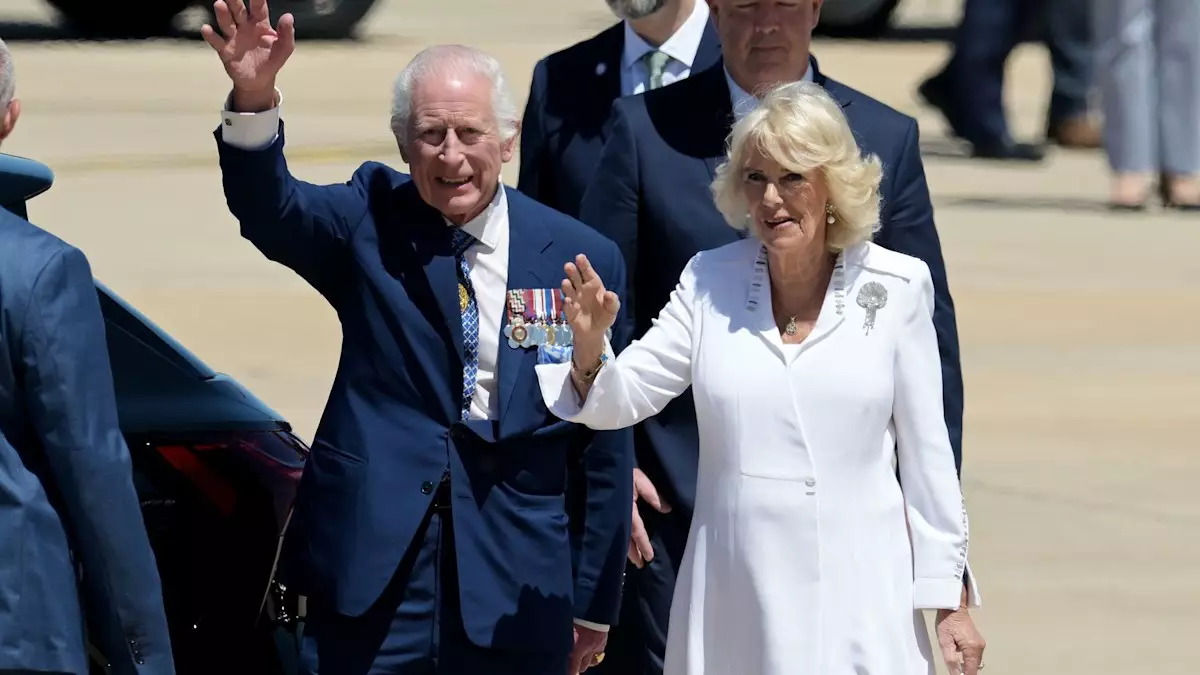The arrival of King Charles and Queen Camilla in Australia’s capital, Canberra, on Monday heralded a joyful reunion after nearly ten years. This visit is not merely ceremonial; it signifies a reconnection between the monarchy and a country that has historically maintained a complicated relationship with the Crown. Dressed elegantly in a white silk crepe dress by Anna Valentine, Queen Camilla’s style subtly echoed the royal legacy, particularly with her choice to wear a distinctive diamond and pearl brooch once belonging to the late Queen Elizabeth. This connection to the past not only honored her predecessor but also resonated deeply with the Australian audience.
For King Charles, this journey marks his 16th official trip to Australia, a nation that holds profound significance in his personal history. His schooling stint there in 1966 remains a defining chapter in his life. However, the emotional weight of this particular trip is heightened by his recent battle with health issues, specifically a cancer diagnosis disclosed in February. The couple’s visit to the iconic Australian War Memorial serves as a poignant reminder of their commitment to honor the sacrifices of those who served the nation.
Upon their arrival, the couple was met with an outpouring of warmth from the public, indicative of the complex and often affectionate relationship that exists between the Australian people and the royal family. The royal couple’s visit was highlighted by their stop at the Tomb of the Unknown Australian Soldier, a gesture that underlined their recognition of the nation’s history and sacrifices. The gathering crowd, filled with a mixture of ardent royalists and cautious critics, exemplified the Australian spirit. Georgia Bray, a self-identified republican, humorously acknowledged her duality in these moments, stating, “I’m a republican but today I’m a monarchist,” capturing the essence of Australians who set aside their political views to participate in a moment of national conviviality.
In stark contrast, Lynton Martin, a dedicated royal enthusiast donned in a Union Jack suit and crown, illustrated how passion for the Crown continues to thrive among certain segments of the populace. His hopes for a second encounter with King Charles following their meeting in Sydney highlighted not just admiration for the monarchy, but also an eagerness to connect with history in real-time. Such moments suggest that even in a modern and diverse landscape, the monarch often evokes sentiments that transcend political affiliations.
As their visit unfolded, King Charles and Queen Camilla’s itinerary reflected modern royal engagement with pressing issues. During their visit to the Australian Parliament, they were greeted warmly by officials and dignitaries, signifying a welcoming embrace of royalty by political leaders—a notable point in a nation that has, at times, pondered its republican future. Highlighting their commitment to Australia’s environmental problems, particularly the bushfire crisis, the King observed a demonstration at the National Bushfire Behaviour Research Laboratory. His interest in the innovative “pyrotron,” a tool designed to understand the devastating impact of bushfires, speaks volumes about his lifelong advocacy for environmental sustainability. This commitment underscores a royal legacy that seeks to intertwine duty with significant contemporary issues.
Beginning their tour in Sydney, King Charles and Queen Camilla garnered admiration from hundreds gathered outside St. Thomas’ Anglican Church, showcasing a vital connection the royal family has with the people. Such enthusiasm might reflect not only a fascination with the royal family but also a deeper understanding of their roles within the Commonwealth. Moreover, this visit is emblematic of the balanced relationship that Australia continues to navigate with its colonial past while embracing its identity as an independent nation.
As the royal couple continues their tour, including engagements in Samoa, the visit serves as a testament to King Charles’ belief in strengthening Commonwealth ties. Their journey represents more than ceremonial duties; it is a reaffirmation of the monarchy’s relevance and commitment towards collaborative futures, even as they face personal challenges. Ultimately, this visit offers a narrative straddling history, emotion, and modern responsibility—a celebration and contemplation of a royal legacy firmly rooted in Australian hearts and minds.

Leave a Reply